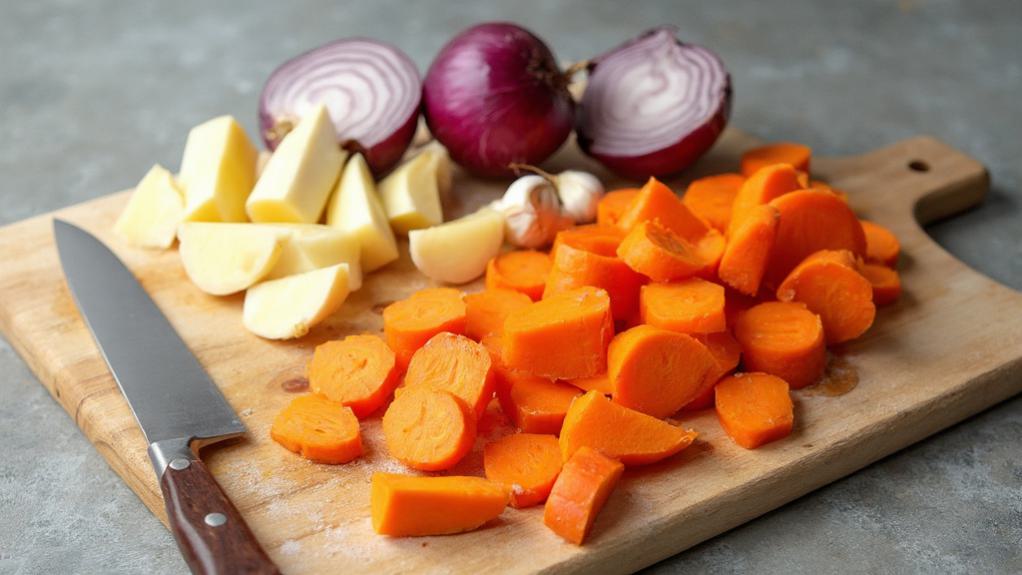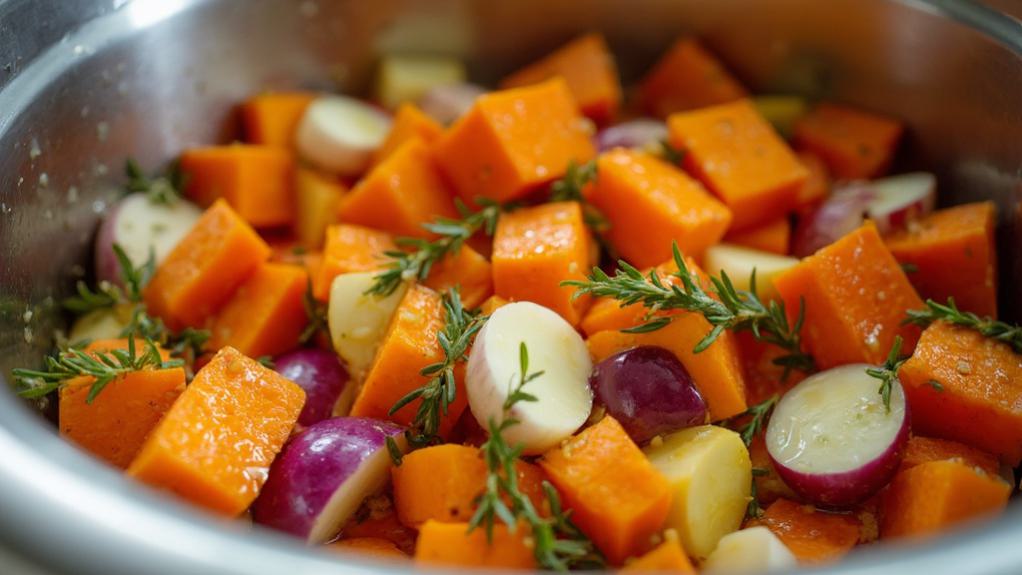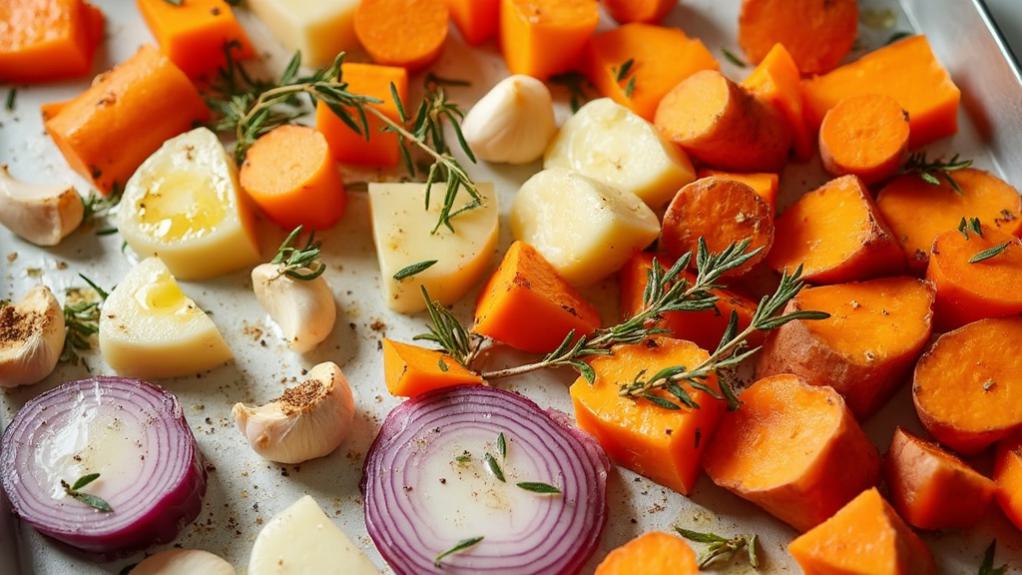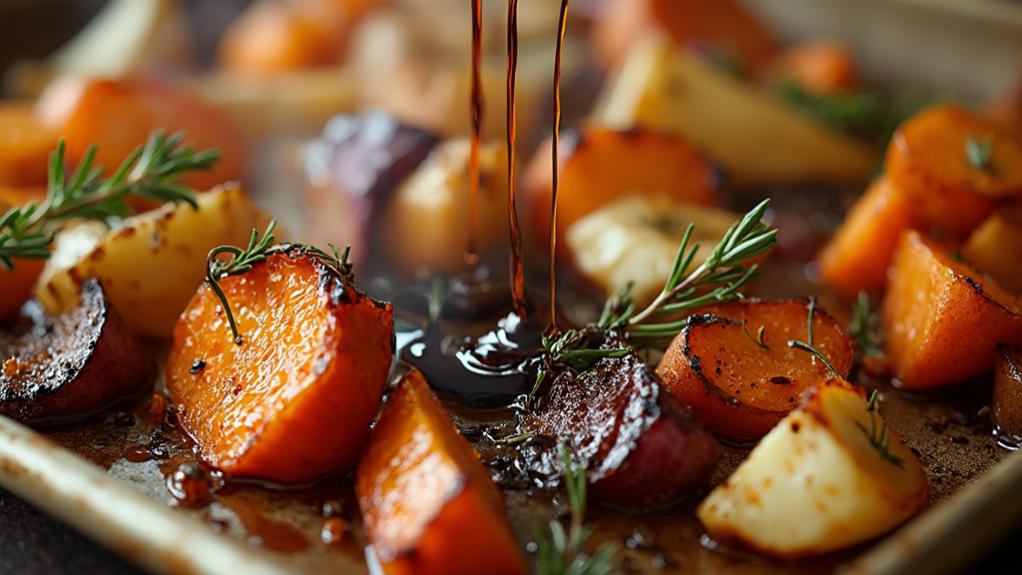I’ve discovered that the secret to transforming humble root vegetables into something extraordinary lies in the roasting process. When I expose parsnips, carrots, and sweet potatoes to high heat, their natural sugars caramelize into a complex sweetness that plain steaming or boiling can never achieve.
My favorite part is how the edges become crispy and golden while the interiors stay tender and creamy. I’d love to share my technique for creating this elegant yet rustic dish that elevates any winter meal from basic to sublime.
Recipe
This classic roasted root vegetable medley celebrates the natural sweetness and earthiness of seasonal vegetables, transformed through the magic of high-heat roasting. Each vegetable contributes its unique character to create a harmonious blend of flavors and textures.
When roasted together, these vegetables caramelize beautifully, developing crispy edges and tender centers. The combination of fresh herbs and balsamic vinegar enhances their natural flavors while adding depth and complexity to this wholesome vegan dish.
- 2 medium parsnips, peeled and cut into 1-inch chunks
- 3 large carrots, peeled and cut into 1-inch chunks
- 2 medium sweet potatoes, cut into 1-inch chunks
- 1 large red onion, cut into wedges
- 4 whole garlic cloves, peeled
- 3 tablespoons extra virgin olive oil
- 1 tablespoon fresh thyme leaves
- 1 tablespoon fresh rosemary, chopped
- 1 teaspoon sea salt
- 1/2 teaspoon freshly ground black pepper
- 2 tablespoons balsamic vinegar
Preheat oven to 425°F (220°C). In a large bowl, combine all vegetables with olive oil, herbs, salt, and pepper, tossing until evenly coated. Spread the vegetables in a single layer on a large baking sheet, ensuring they aren’t overcrowded.
Roast for 40-45 minutes, turning once halfway through. During the final 5 minutes of cooking, drizzle with balsamic vinegar and return to the oven until the vegetables are tender inside and caramelized outside.
For optimal results, ensure all vegetables are cut to similar sizes for even cooking. Allow vegetables to reach room temperature before roasting, and use two baking sheets if needed to prevent overcrowding. If vegetables begin to brown too quickly, cover loosely with foil.
Store leftovers in an airtight container in the refrigerator for up to 4 days, reheating in a 350°F oven until warmed through.
Step-By-Step Cooking Instructions
You’ll begin by preheating your oven to 425°F and cutting your vegetables into uniform chunks to ensure even cooking.
Next, you’ll toss the vegetables with olive oil, fresh herbs, salt, and pepper before spreading them in a single layer on a baking sheet.
After roasting for about 40 minutes and turning once halfway through, you’ll finish by drizzling balsamic vinegar over the vegetables for the final 5 minutes of cooking.
Step 1. Preheat Oven to 425F

Prior to gathering any ingredients, set your oven to preheat at 425°F (220°C). This temperature is crucial for achieving the perfect balance of caramelized exteriors and tender centers in your root vegetables.
While your oven heats, you’ll have time to prep your vegetables and gather your seasonings. You’ll want to ensure your oven reaches the full temperature before introducing the vegetables, which typically takes 10-15 minutes in most modern ovens.
During this preheating period, you can arrange your oven racks to accommodate your baking sheets – the middle position usually works best for even heat distribution.
If you’re using a convection setting, you’ll want to reduce the temperature by 25 degrees to 400°F (205°C), as the fan circulation intensifies the heat.
Check your oven’s actual temperature with an oven thermometer if you have one available, as many ovens can run slightly hot or cool. This precise temperature control will ensure your root vegetables roast consistently, developing those desirable crispy edges while maintaining their moisture inside.
Step 2. Cut Vegetables Into Chunks

Begin by preparing your root vegetables with consistent sizing, aiming for chunks approximately 1-inch in diameter. Start with the parsnips, peeling them thoroughly and cutting them diagonally into uniform pieces.
Move on to the carrots, removing their outer skin and slicing them into similar-sized chunks, ensuring they’ll cook at the same rate as the parsnips.
Next, tackle the sweet potatoes. There’s no need to peel them if you prefer the skin on – just scrub them well and cut them into 1-inch cubes.
For the red onion, trim off the ends and remove the papery skin, then cut it into wedges, keeping the root end intact so the layers stay together.
Finally, peel your garlic cloves but leave them whole – they’ll roast into sweet, tender morsels.
As you’re cutting, place all vegetables in a large bowl. Don’t worry if some pieces aren’t perfectly uniform, but try to keep them close in size.
Remember that smaller pieces will cook faster and larger ones will take longer, so consistency is key for even roasting.
Step 3. Toss With Oil and Herbs

Now that your vegetables are perfectly sized, it’s time to enhance their natural flavors with a coating of oil and aromatic herbs. In a large mixing bowl, combine three tablespoons of olive oil with fresh thyme leaves and chopped rosemary.
Add the sea salt and black pepper, then whisk briefly to blend the seasonings with the oil.
Add your prepared root vegetables and garlic cloves to the bowl. Using clean hands or two large spoons, gently toss the vegetables until they’re evenly coated with the oil and herb mixture.
You’ll want to ensure each piece is properly dressed, as this coating not only adds flavor but also helps create that desirable caramelized exterior during roasting.
Take care not to break or mash the vegetables as you toss them. If your bowl seems too crowded, work in batches to achieve an even coating.
The oil should leave a light, glistening sheen on each piece, while the herbs should be distributed throughout. Once you’ve achieved an even coating, you’re ready to arrange the vegetables on your baking sheet for roasting.
Step 4. Roast on Baking Sheet

The perfect roasting setup begins with positioning your oven rack in the middle.
Step 5. Drizzle Balsamic & Finish

During the final five minutes of roasting, you’ll want to retrieve your vegetables from the oven and drizzle them with balsamic vinegar. The vinegar adds a sophisticated layer of sweet-tart complexity that perfectly complements the caramelized edges of your root vegetables.
Return the baking sheet to the oven immediately to allow the balsamic to reduce slightly and create a light glaze.
You’ll know your vegetables are finished when they’re tender enough to pierce easily with a fork and have developed a rich, golden-brown exterior. The garlic cloves should be soft and creamy, while the onion wedges will have caramelized edges.
The sweet potatoes, carrots, and parsnips should maintain their shape while offering minimal resistance when pierced.
Let your roasted vegetables rest for about 5 minutes before transferring them to a serving platter. During this time, they’ll continue to steam slightly, achieving their final perfect texture.
If you’d like, you can finish the dish with an extra drizzle of high-quality olive oil and a sprinkle of fresh herbs to brighten the presentation.
Why I Love This Dish
I’ve fallen head over heels for this roasted root vegetable medley because it transforms humble ingredients into something truly magical. The way each vegetable caramelizes in the oven, developing deep, complex flavors that you simply can’t achieve through other cooking methods, makes this dish a standout on my table.
I’m particularly drawn to how the sweet potatoes become tender and creamy, while the parsnips develop an almost nutty character.
What I appreciate most is the dish’s versatility. I’ll serve it alongside a holiday roast, but it’s equally at home on a casual weeknight dinner plate. The leftovers are incredibly versatile too – I’ll toss them into salads, fold them into grain bowls, or purée them into a velvety soup.
The combination of fresh herbs and that final touch of balsamic vinegar elevates these everyday vegetables into something worthy of company, yet it’s simple enough that I can prepare it while helping my kids with homework.
It’s the perfect balance of nutritious and delicious, and that’s why it’s become a staple in my cooking repertoire.

Leave a Reply